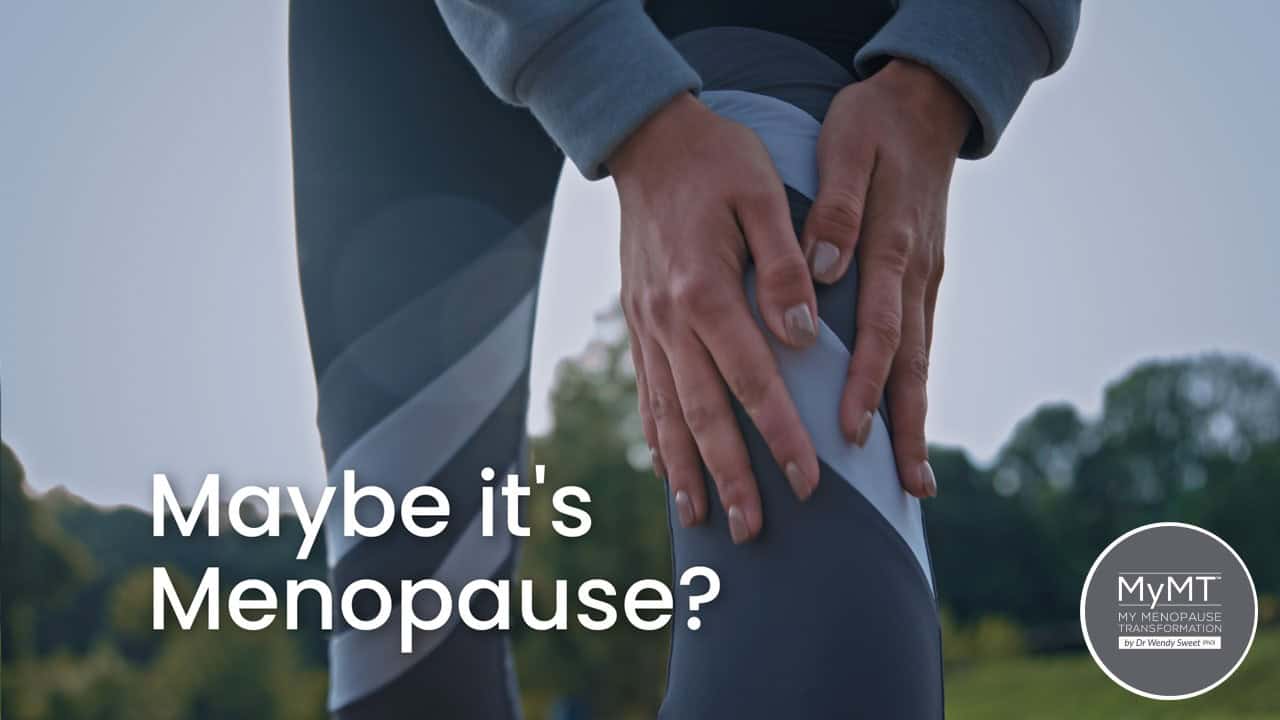Oestrogen has a role to play in cell turn-over and healing of our joints. So, what happens as we move through menopause, when we don’t produce as much oestrogen?
It’s not often that a week goes by when I don’t receive messages and emails from women who are curious to know if their sore joints, aching knees and restless legs are anything to do with menopause.
It’s the same when women come to my live-events. When I enquire who has sore joints and muscles, numerous hands would shoot straight up. Most hadn’t realised that their sore joints, aching muscles, sore knees and restless legs were a symptom of menopause. Surprisingly, many women believe that they are on the trajectory towards osteoarthritis, something that they’ve also seen in their mother’s generation too.
That’s why I have some questions for you.
- Is joint and muscle pain affecting your ability to participate in regulat exercise or stay active as you move through menopause or if you are already in post-menopause?
- Are you experiencing sore knees, or joint pain for the first time since entering menopause?
- Or has your joint and/or muscle pain increased since menopause?
If you answered yes to these questions, you’re not alone. Over 500,000 women globally have completed my Menopause Symptoms Quiz and 80% of them state that they have sore joints.
When I reached my early 50’s, my joints began to ache. I thought it was due to weight gain and years of high-impact exercise. It’s no surprise that my past ‘exercise life’ flashed through my mind!
Many women experience joint and muscle health changes as they arrive in midlife, and I talk about this in my Masterclass on Menopause. So, if you haven’t managed to purchase your 3 months access to this 2 hr webinar (only NZ$15/AUS$13/CAN$11 or £7) that is online for you, then have a listen to the video below, where I explain why you should watch it sometime!
Then scroll down to read more about your aching knees and painful joints as you arrive in midlife.
Understanding the ‘Wear and Tear Theory of Ageing’:
As the first generation of women to enter the menopause transition in the context of the changing exercise environment over our lifetime, the ‘wear and tear theory’ of ageing matters. So too, does the role of oestrogen in our joints and muscles, and for those of you who don’t exercise regularly, this is relevant to you.
Declining oestrogen levels during menopause cause joints to lose some of the lubrication function. Oestrogen is involved in joint lubrication as well as tendon and ligament elasticity.
Furthermore, because progesterone is a natural anti-inflammatory agent and helps joint tissues to relax, the decline in both oestrogen and progesterone, may contribute to worsening inflammation and dryness in your joints.
For those of you who have undertaken regular exercise for years, then you may have found that your joints and muscles ache more, or you are experiencing more frequent injuries than you are used to. Is this you?
According to the Australasian Longitudinal Studies on Women’s Health, it’s part of the reason many women give up on exercise during their menopause transition. But here’s the good news – it doesn’t have to be like this. You can make regular exercise part of your life again and reduce your risk of osteoarthritis too.
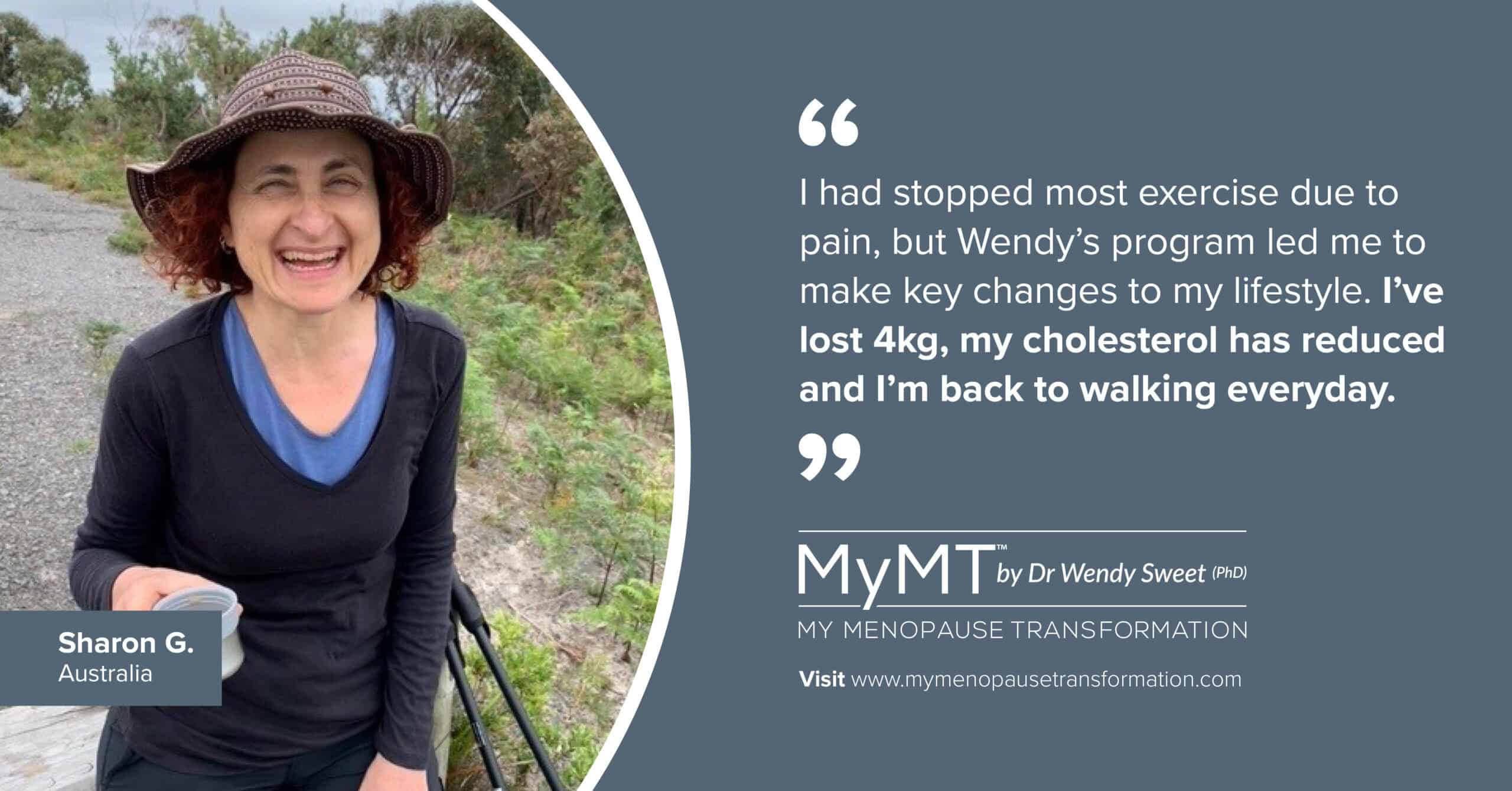
When I began to look at Theories on Ageing as part of my doctoral studies, I realised that I needed to look through the ‘wear and tear’ lens in relation to joint health during menopause.
The ‘Wear and Tear Theory of Ageing’ was first introduced in 1882, by Dr August Weismann, a German biologist.
He believed that cells and tissues have vital parts that wear out resulting in more rapid ageing from the accumulation of inflammation. Like components of an ageing car, parts of the body eventually wear out from repeated use.
Scientists now know that there is some basis to this theory. Hence, reducing inflammation and adhering to an anti-inflammatory diet, is one of your goals during your menopause transition.
Newer research also suggests that declining oestrogen levels also impact the fascia and there may be an association between increased fascia thickness and reduced joint flexibility in patients with chronic pain. (Wilke et al, 2019).
Fascia is a thin casing of connective tissue that surrounds and holds every organ, blood vessel, bone, nerve fibre and muscle in place.
The tissue does more than provide internal structure; fascia has nerves that make it almost as sensitive as skin. If you’ve noticed that you are less flexible as you move through menopause or your muscles feel generally ‘stiffer’, then your ageing fascia may be the reason.
Our menopause transition is now recognised as a vulnerable time for increased inflammation and sore joints and increased risk for heart disease, are just a couple of examples of this.
This is why the Menopause transition is the time to focus on a healthy diet and increase certain nutrients that heal and restore your joints. Sleep improvement is also important as is turning around gut health, so you can absorb the nutrients – all solutions which I have for you in the MyMT™ programmes.
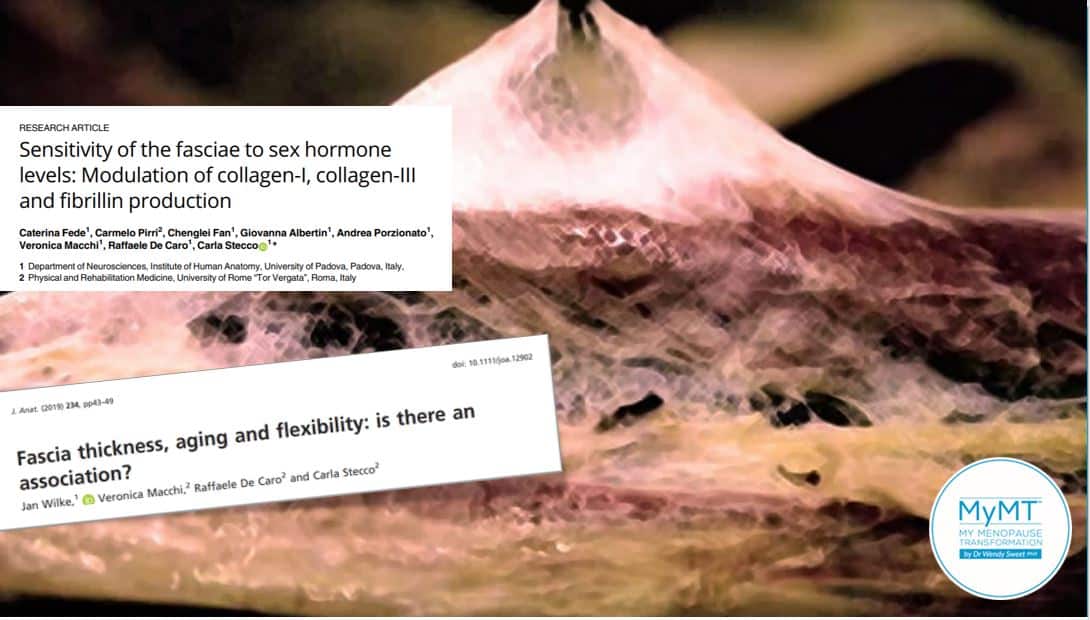
Oestrogen plays an important role in our joint and muscle health …
It was when I was teaching exercise and sports science students about the role of oestrogen in female athlete knee injuries that I had my ‘lightbulb moment’.
If oestrogen is important for joint stability and the maintenance of integrity in the tendons and ligaments (especially in knees), of female athletes, then what happens when we lose oestrogen? This was my curiosity.
Oestrogen is essential for our joints and muscles, because its role is to protect and stabilize membranes.
As a fat-soluble hormone, oestrogen helps to strengthen the cell membrane and in so doing, it assists as an antioxidant or anti-inflammatory compound.
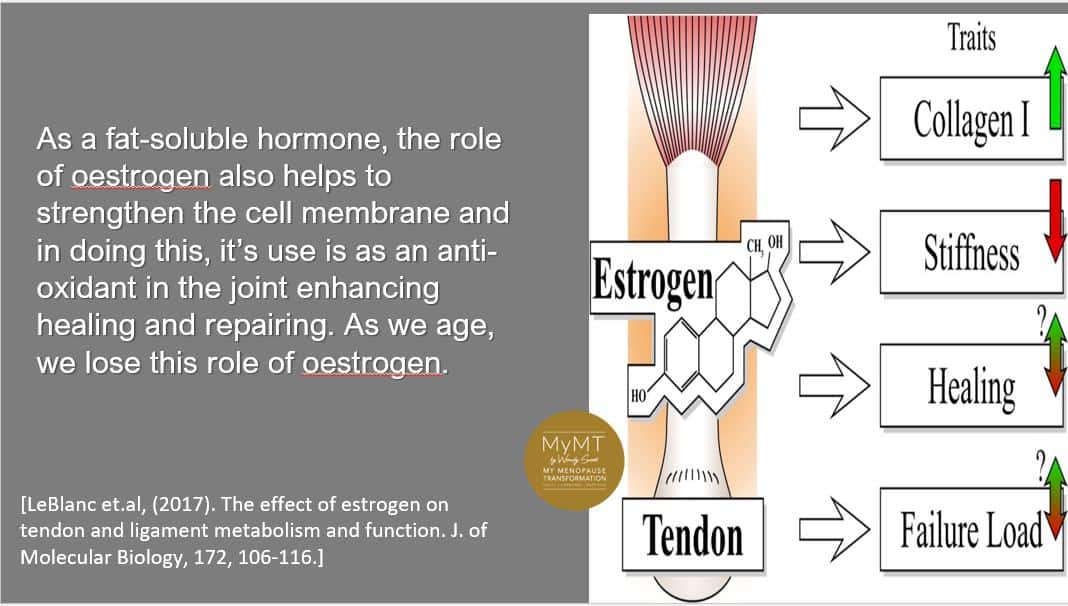
Changing your diet to an Anti-inflammatory Diet is important:
As I often say to women on my programmes, before embarking on too much exercise, it’s important to reduce inflammatory changes in joints and muscles by:
- Sleep all night which helps with reducing inflammation.
- Have specific nutrients that support joint health.
This is why I want to share with you the powerful nutrient your joints will love!
Olive oil, Anti-inflammatory Diet and Joint Health – the powerful connection
Whenever I receive health screening forms in my in-box from women who sign up to the MyMT™ programmes, I look carefully to see if they have ticked the box indicating they are experiencing joint pain which has come on since they reached menopause. Over 80% of women tick that box.
When I ask what their doctor or physio has said about their joint pain, invariably their response is ‘they can’t find anything wrong.’
Through my women’s healthy ageing studies, I discovered the incredible role that Extra Virgin Olive Oil has in reducing inflammation in the body as we age.
I encourage the use of omega 3-rich olive oil and discourage the popular dietary emphasis on coconut fats and various cooking oils, which have not been researched specifically against our need to improve joint health in menopause.
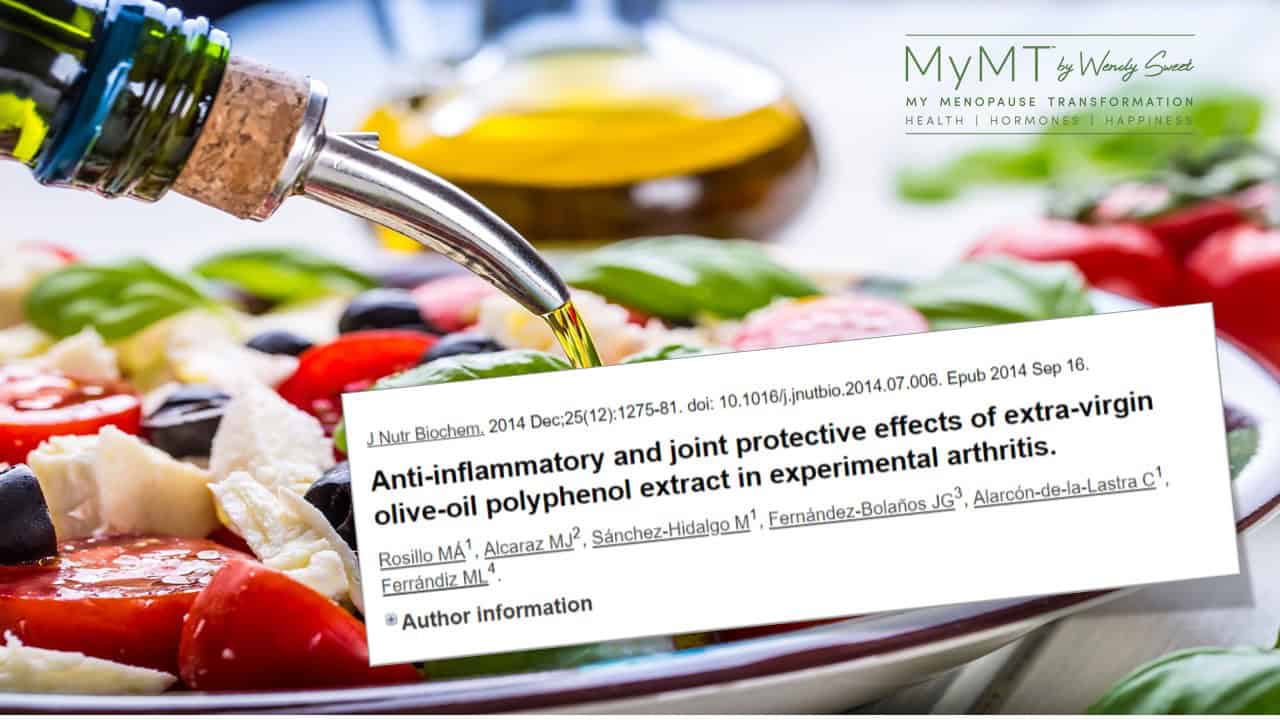
Nutrients for reducing inflammation in your joints and muscles come from olive oil – especially the nutrients oleocanthal and vitamin E. According to Australia’s Olive Wellness Institute, adding olives and Extra Virgin Olive Oil to the diet is crucial to reducing joint pain, reducing sore knees and reducing your risk of heart disease as you age.
Olive oil contains tocopherol (vitamin E); coconut oil doesn’t. Tocopherol or vitamin E is a powerful anti-oxidant necessary for hormonal and joint health during our menopause transition. It helps to repair damaged cell membranes and other foods high in Vitamin E, include sunflower seeds and almonds.
Vitamin E is unique among vitamins because the biological activity of it varies considerably and for its adequate absorption, it requires fat digestion to be functioning normally. This means you need a healthy liver!
The recommended daily intake from the FDA in America is 15mg daily but in New Zealand the recommended daily intake is 7-10mg, so take your pick!
I recommend olive oil on the MyMT™ programmes as this has around 1.5 mg of vitamin E per tablespoon. Avocadoes, almonds, sunflower seeds and hazelnuts are high in vitamin E, as is kumara (sweet potato):
“Evidence from randomised controlled trials shows olive oil exerts beneficial effects on markers of inflammation and endothelial function.” [Schwingshackl et al., 2015].
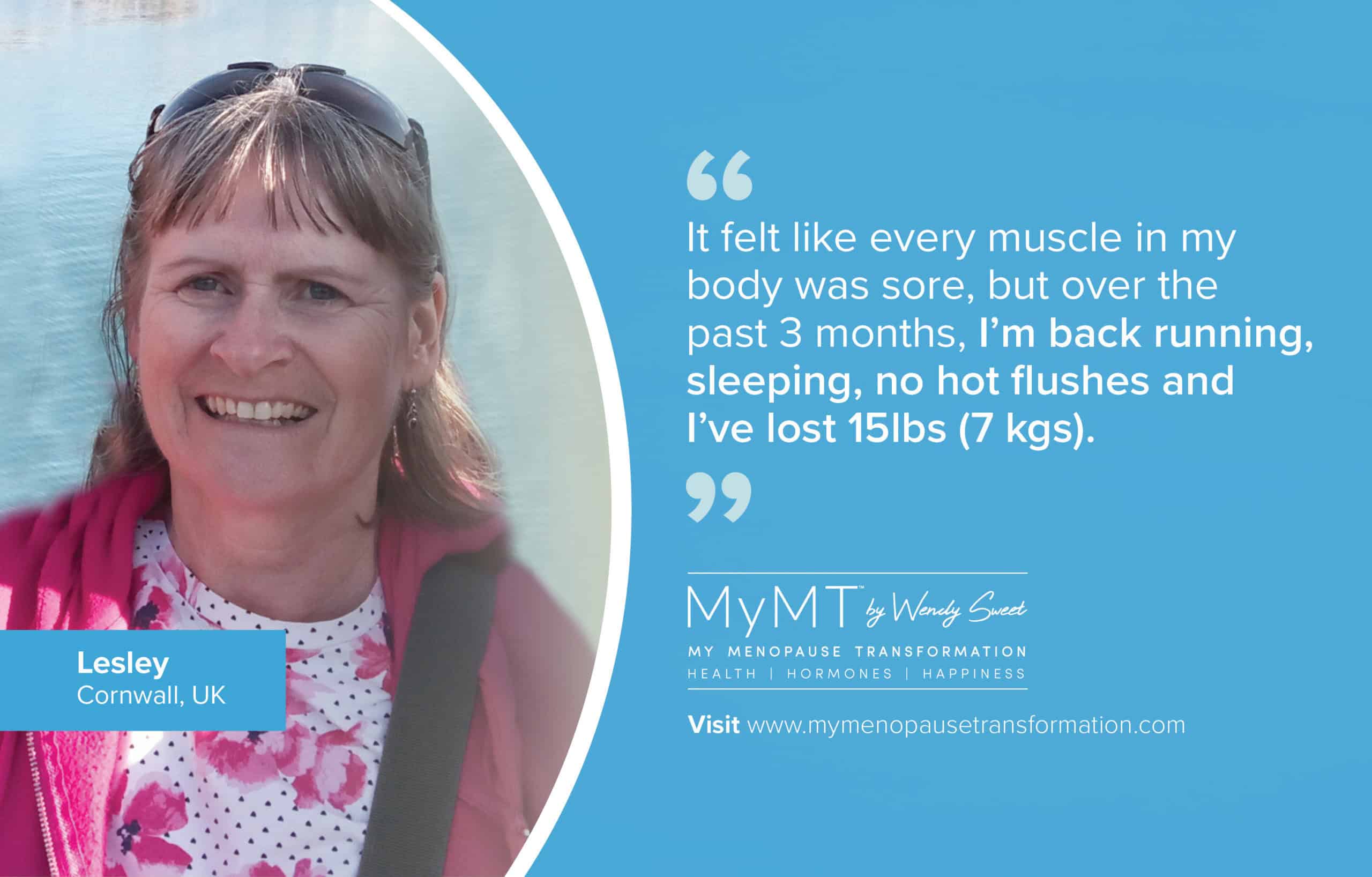
There is so much information about how to look after our health these days, but as I discovered too, very little of it is supported by research specific to menopause.
With menopause heralding the gateway to your biological ageing, it’s time to ensure that your joints stay working for you, and that your bone health is ideal as well. It came through loud and clear from my research studies, that women wanted to maintain optimal movement and function as they aged. I agree!
Note: If you do have joint pain that is causing you increasing pain or discomfort, I encourage you to get it checked out with your physio or medical provider as well.
I also encourage you to join me on the My Menopause Transformation programmes and it is my privilege to offer you a SPECIAL OFFER of NZ$50* off as well as my FREE BONUS MODULE in each programme, called ‘Restore your Joyful Joints‘ when you apply the exclusive promo code. If you aren’t sure about the programmes, then I invite you to listen to my video below as I explain them to you.
Your exclusive promo code is: JOIN MYMT
* [NZ$349 = approx. AU$317, US$206, CA$283, £165, €193]
My 12 week programmes are:
CIRCUIT BREAKER for thinner/ leaner women
TRANSFORM ME for women wanting to lose their menopause weight and restore their joint health.
BEYOND MENOPAUSE for women in their post-menopause years, who want to understand the lifestyle changes for their healthy ageing.
How the programmes work, is in the video below.
From peri-menopause to your post-menopause years, there is never a better time to start, but if you are hesitating, then I recommend you complete the MyMT™ Symptoms Quiz, watch the MyMT™ Masterclass on Menopause, go to the Testimonials and Success Stories on the MyMT™ website and read the stories from women just like you.
MyMT™ 12 week programs are normally available for NZ$399 each, but this exclusive offer of NZ$50 off is yours to use right now. Please apply the promo code JOIN MYMT to either of the Circuit Breaker or Transform Me programmes.
It would be my privilege to support you.
Dr Wendy Sweet, (PhD), Member: Australasian Society of Lifestyle Medicine/MyMT™ Founder & Coach
References:
Chung E, Mo H, Wang S, Zu Y, Elfakhani M, Rios SR, Chyu MC, Yang RS, Shen CL. Potential roles of vitamin E in age-related changes in skeletal muscle health. Nutr Res. 2018 Jan;49:23-36. doi: 10.1016/j.nutres.2017.09.005.
Exercise-Induced Muscle Damage and the Protective role of Estrogen. Sports Med.2002, 32(2), 103-123]
Fede C, Pirri C, Fan C, Albertin G, Porzionato A, Macchi V, De Caro R, Stecco C. (2019). Sensitivity of the fasciae to sex hormone levels: Modulation of collagen-I, collagen-III and fibrillin production. PLoS One. 26;14(9):e0223195.
Khor SC, Abdul Karim N, Ngah WZ, Yusof YA, Makpol S. Vitamin E in sarcopenia: current evidences on its role in prevention and treatment. Oxid Med Cell Longev. 2014;2014:914853.
Rosillo, M., Alcaraz, M. et al. (2014). Anti-inflammatory and joint protective effects of extra-virgin olive-oil polyphenol extract in experimental arthritis,
The Journal of Nutritional Biochemistry, 25, 12, 1275-1281.
Schwingshackl, L., M. Christoph, and G. Hoffmann (2015). Effects of Olive Oil on Markers of Inflammation and Endothelial Function-A Systematic Review and Meta-Analysis. Nutrients, 7(9): p. 7651-75.
Wilke J, Macchi V, De Caro R, Stecco C. (2019). Fascia thickness, aging and flexibility: is there an association? J Anat. 234(1):43-49. doi: 10.1111/joa.12902.
Related Tag: Joint Pain in Menopause
